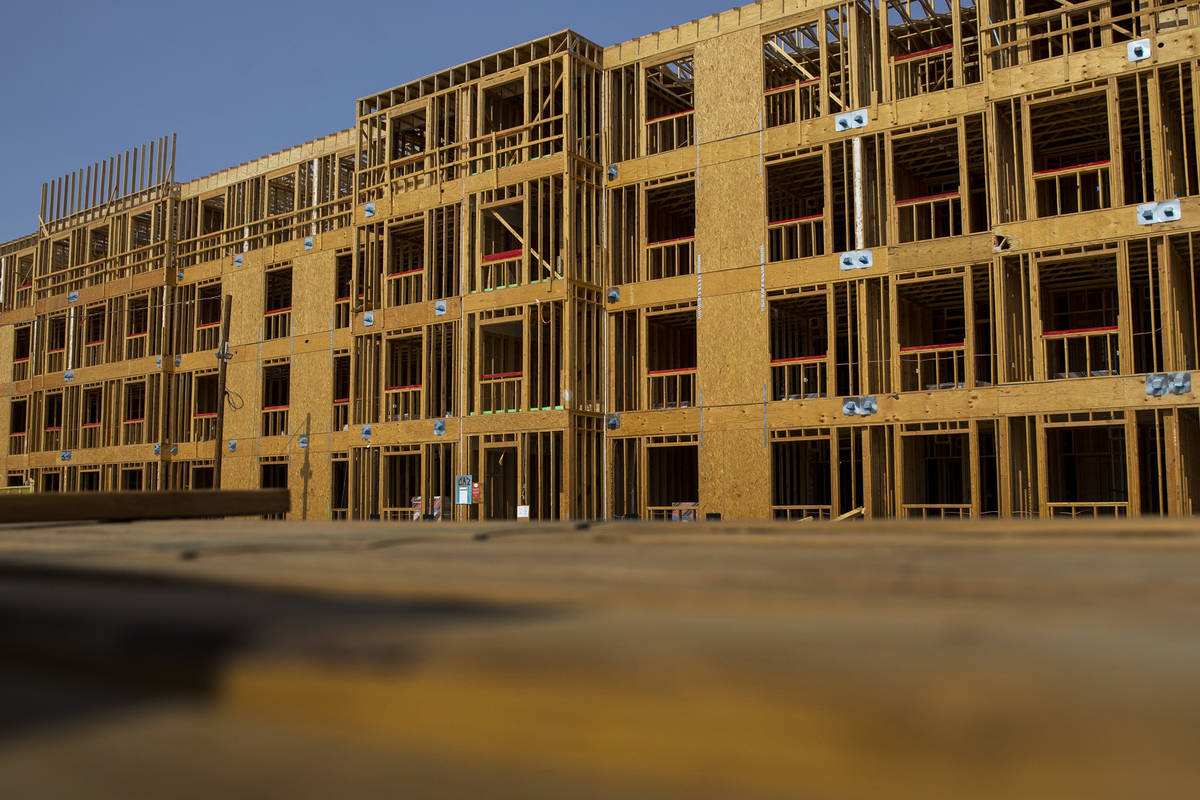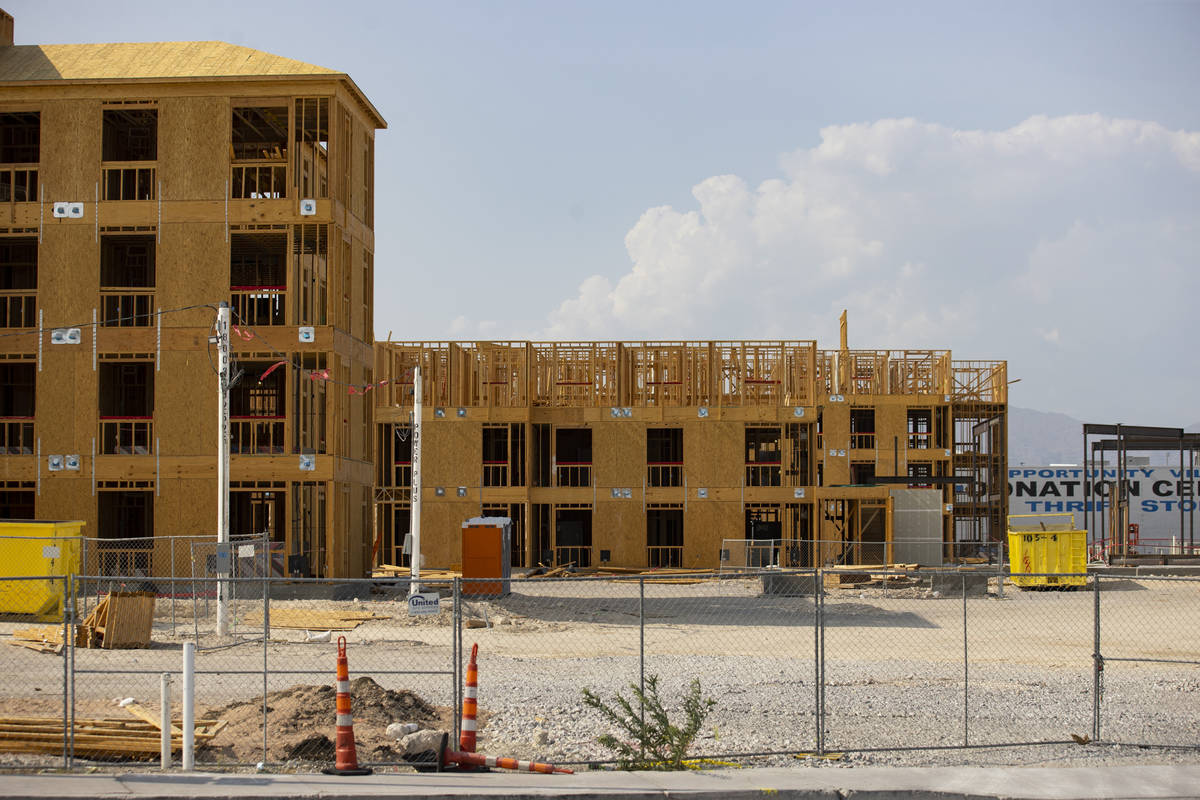Construction supply chain shortages hurting nonprofit homebuilders
Disruptions in the supply chain throughout the construction industry are hitting Las Vegas-area nonprofits dedicated to keeping housing affordable — because costs for building materials are far from it.
More than a year of operating without volunteers, watching prices flucutate and typical revenue sources change has challenged housing and repair-focused nonprofits to build through the barriers, some group leaders said.
Project changes
At Nevada HAND, the state’s largest nonprofit that develops and manages affordable senior and family rentals, leaders have noticed the ever-changing cost of materials. Prices can vary wildly, putting developers in a difficult position to figure out the best time to buy, said executive vice president of construction Robert Feibleman.
Take lumber: The commodity hit a peak price in May, when it cost nearly $1,700, according to the NASDAQ. It’s dropped sharply since, to about $550. That’s still several hundred dollars more than pre-pandemic price tags. Furthermore, the drop takes time to reach builders.
“I’ve been doing this for 43 years and I’ve never seen anything like it,” Feibleman said. “In the old days we talked about lumber and drywall, sometimes concrete. But today we are talking about everything, from air conditioners to insulation to nails. They are all up significantly.
“It’s one thing to see a product go up 2 percent to 5 percent annually, but now we get notices that something is going up 30 percent at the end of the month and on allocation, and then another letter three months later with another big increase. It’s shocking and there’s no way to prepare for it.”
All this comes as Nevada HAND builds its largest project to date. The 480-unit Decatur Commons on Alta Drive and Decatur Boulevard will split evenly between low-income family and senior housing. An interest list for the project, expected to complete in early 2022, is already 1,000 names long.
Changes caused by the COVID-19 pandemic led Habitat for Humanity Las Vegas to build two homes last year, CEO Douglas Coombs said. That’s below its typical range of four to seven homes. A competitve real estate market, material shortages and the lack of volunteers all contributed, he said.
But some of the challenges were nothing new to Coombs. Getting affordable resources tends to be competitive in fast-growing real estate markets and it’s not unexpected.
“We have to get creative,” Coombs said.
Some nonprofits are left to lean on business partners like subcontractors, agencies and suppliers to ensure projects stay close to budget. Leaders say decades of working relationships have left room for negotiation, discounts or other help.
“I learned in the ’80s that what goes around comes around,” Feibleman said. “We were busy during the economic downturn and stayed loyal to our team and conversely, even though the team is busy now, they have long memories and are taking care of us.”
How residents will see it
The long-term impact depends on how long prices remain inflated. Cost won’t necessarily be passed onto nonprofits’ clients since they are receiving mission-produced work to make something affordable. At Decatur Commons, for instance, rent will be set based on an individual’s income — they must make between 30 and 80 percent of the area median income. But, inflated prices could affect an agency’s ability to provide more resources down the road, said Waldon Swenson, vice president of corporate affairs at Nevada HAND.
“When we talk about the impact on residents, it’s not from a rent standpoint, it’s the people who are going to miss out that need more housing built,” Swenson said. “That’s why we remain diligent and working towards achieving our mission of building affordable housing and providing those supportive solutions.”
Because material shortages extend beyond lumber, other nonprofits see the costs rising, too. Bob Cleveland, the executive director at Rebuilding Together Southern Nevada, said his nonprofit dedicated to critical home repairs for low-income seniors, veterans and people with disabilities has seen prices rise or materials take longer to arrive in window, roof and door repairs.
“It makes it a little harder to get things done for our clients and takes a bit longer for us to give them a safe and healthy home,” Cleveland said.
Footing the inflated bill
Rebuilding Together was recently awarded $125,000 through the U.S. Department of Housing and Urban Development to fund repairs for low-income veterans over the next four years. The grant is one of many dispursed through federal stimulus packages to offset the pandemic’s impacts.
It’s vital, Cleveland said, because it suppresses rising housing costs and increasing need for affordable housing.
“Every house we repair and keep a low-income person living in is one more affordable housing unit that remains on the market,” Cleveland said. “If our client, for example, cannot live in their house anymore because there’s no air conditioner, they have to move on. They will probably end up in a low-income senior apartment that they have to rent or an assisted living facility. That’s one less spot for somebody else that doesn’t have that opportunity. So, we want to keep these people in their homes as long as possible.”
Revenue at Habitat ReStores, secondhand stores that provide operating revenue for Habitat for Humanity groups, dropped about 10 percent in 2020, Coombs estimated. He said that primarily had to do with the brief shutdown in early spring.
For Habitat for Humanity, Coombs said the organization had to get creative to stay on track. They, too, ask partnering stakeholders for discounted rates on supply and labor. The nonprofit also plans to launch an e-store for ReStores in the valley and a direct marketing campaign to increase donations to the group.
Two homes are slated to break ground in September, Coombs said. They’ll be about 400 square feet smaller than last year’s homes, partly to make the construction more affordable and to make the home maintenance more affordable for the future homeowners.
“We do expect to pay more, but we’re looking at ways to increase the fundraising, partnerships and volunteerism to offset some of the costs,” Coombs said. “The costs are still there, there’s no question about it. But we have to be smart about it and look at ways we can increase revenue through e-commerce, direct mail campaigns, and other things that are just smart business decisions.”
McKenna Ross is a corps member with Report for America, a national service program that places journalists into local newsrooms. Contact her at mross@reviewjournal.com. Follow @mckenna_ross_ on Twitter.
































